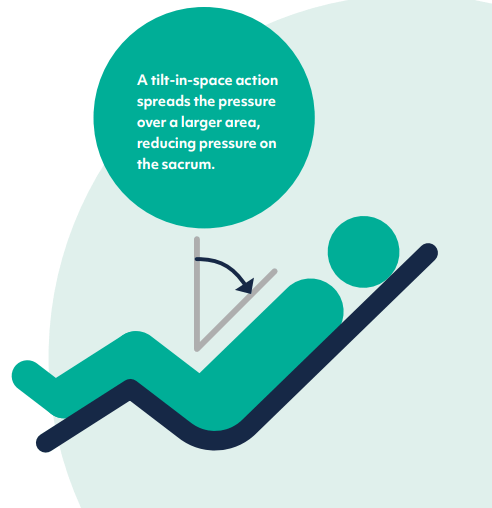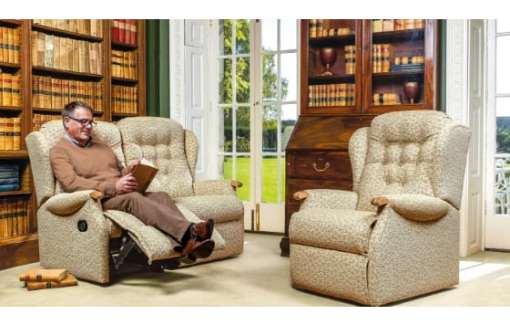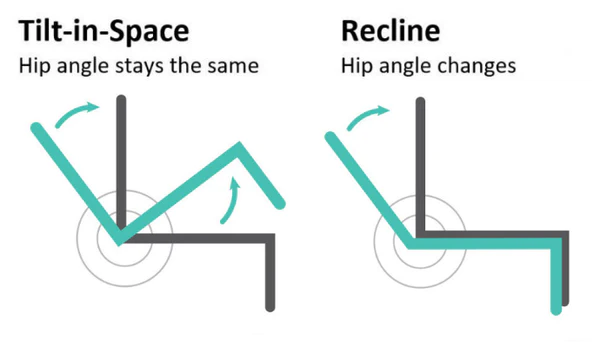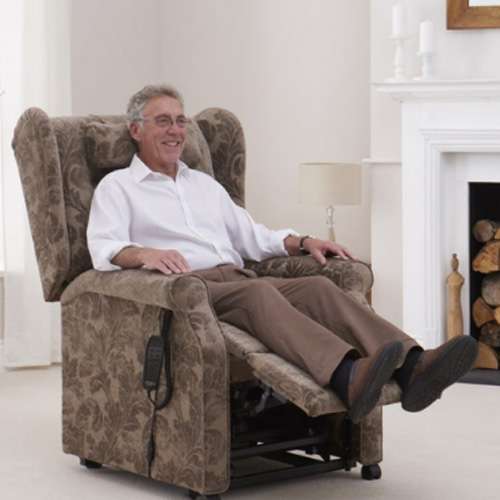In this blog, we’ll dive into the differences between tilt-in-Space chairs and standard recliner chairs, outlining their unique functionalities and benefits. By the end, you’ll have a clear understanding of which chair suits your specific needs.
Jump straight to…
Definitions
What is Tilt-in-Space?
A tilt-in-space chair tilts the user back in the chair while maintaining the same sitting angle between the seat and backrest.
‘True tilt-in-space’ keeps a 90 degree angle between the seat, backrest, and footrest, effectively tilting the seat as a single unit.
This mechanism can be motorised or manual, and is available across our range of riser recliners and care chairs because of the medical benefits it brings.

Tilt-in-space functionality
What are Standard Recliners?
A standard recliner chair, which can be found in most home and furniture stores, usually features a reclining backrest and elevating footrest that allows the user to recline back in the chair and put their feet up. Some chairs also feature an electric rise mechanism that helps the user stand to their feet by operating the handset.
This mechanism is common in living room armchairs and leisure and entertainment venues.
Sometimes the above options can be combined to provide extra positioning capabilities in the chair, as covered below.

Standard recliner chair and sofa
Key Differences and Benefits
The key difference between the two types of chairs is the way the user is positioned in the chair and the ergonomic effects this has.
Tilt in space maintains a fixed sitting angle when the user is tilted back in the chair, which redistributes the pressure from the ITs (sit bones) across the legs and upper back, whilst reducing shear friction. Aside from pressure relief and increased comfort, this has multiple health benefits, including:
- More centralised posture
- Improved breathing and swallowing
- Improved circulation
- Reduces swelling and inflammation
Standard recline alters the user’s sitting profile, as the back angle increase relatives to the seat. This is best for ambulant users who are able to reposition their sitting posture easily, otherwise, the movement of the backrest can create shear friction and cause the user to slide forward in the chair.
Therefore, standard recliners are not classed as medical chairs, so are unsuitable for people with pressure relief and postural support needs.
As a result, price ranges between the two vary, with tilt-in-space chairs more expensive than standard recliners that are positioned as more affordable.

The difference between Tilt in Space & Standard Recline
Which Type of Chair Should I Use?
Tilt-in-space chairs offer therapeutic benefits for individuals with medical needs, such as preventing pressure sores and improving posture. As a result, they are best for individuals with limited mobility, disabilities, or medical conditions like the following that require specific seating support:
- Parkinson’s disease
- Multiple sclerosis
- Stroke recovery
- Arthritis
They are also an advantage for people who need hoisting into the chair, as the tilt-in-space helps position them to the back of the chair and keep an upright posture.
There are various types of tilt-in-space riser recliner chairs you should be aware of, to suit specific postural needs:
Single Motor Tilt-in-Space
Single motor tilt-in-space is the standard option which tilts the chair back whilst raising the legrest, as shown below. Single motor chairs also have a rise function, to lift the person forward into a standing position.

Single motor tilt in space action
Dual Motor Tilt-in-space
Dual motor tilt-in-space has an additional motor to increase the positioning options, by moving the backrest and legrest independently of the seat. This is where tilt-in-space is used in conjunction with recline, as mentioned above. The back angle recline can be increased and even fully reclined into a lying position, providing more scope for pressure relief.

Dual motor tilt in space action
Read our other blog article to find out more on the difference between different riser recliner chair mechanisms.
Standard Recliners provide a basic level of comfort and relaxation, but are more suitable for ambulant users, as they lack the advanced pressure redistribution and postural support features available with tilt-in-space.
The adjustability functions of standard recliners are usually restricted to reclining back angles and footrest extensions. They are ideal for healthy and mobile individuals who are seeking comfort and a cosy space to relax at home, like when watching TV.
A dual motor riser recliner provides these functions, with independent backrest and footrest movement, while the seat angle stays the same.

Dual motor recline
Our Recommendations
With the inherent advantages of tilt-in-space, we would recommend this function over against a standard recliner for people with specific postural and pressure care needs. We usually recommend the single motor action over against dual motor, as this maintains a constant seat-to-back angle and prevents discomfort or shear friction.
In terms of overall levels of comfort, tilt-in-space usually trumps standard recliner chairs every time. The reason for this has to do with simple ergonomics. When the backrest and footrest are operated independently, the person tends to end up either staring up at the ceiling, or experience strain in their hamstring muscles because their legs are pointing straight out while their trunk is upright.
Tilt-in-space allows for adjustments in positioning while maintaining the right overall sitting posture, keeping the different areas of the body in balance and proportion, and increasing overall comfort and wellbeing.

Tilt in space chair
Conclusion
Choosing between a tilt-in-space chair and a standard recliner ultimately depends on your needs. If comfort, relaxation, and affordability are your priorities, a standard recliner is a great choice.
However, if advanced postural support, pressure relief, and medical functionality are essential, a tilt-in-space chair is the better option.
When making your decision, consider factors like mobility needs, health conditions, budget, and daily activities. Both types of chairs have their place, but understanding these key differences helps ensure you make the right choice.
Browse our range
FAQs
What is a tilt-in-space chair?
A tilt-in-space chair tilts the entire seating unit backward as a single unit, keeping the angle between the seat, backrest, and footrest constant (typically 90°). This helps redistribute pressure evenly across the body, reducing strain on the lower back and preventing shear friction.
What is a standard recliner chair?
A standard recliner allows the backrest to recline and the footrest to elevate independently. These chairs are common in homes and are designed primarily for relaxation rather than medical or therapeutic purposes.
What is the main difference between tilt-in-space and standard recliners?
The key difference is how they position the user:
- Tilt-in-space chairs: Maintain a fixed sitting angle while tilting, providing pressure relief, better posture, and reduced friction. They are ideal for individuals with medical or mobility needs.
- Standard recliners: Change the angle between the backrest and seat, which can lead to sliding or discomfort if the user cannot reposition themselves easily.
Who should use a tilt-in-space chair?
Tilt-in-space chairs are recommended for individuals with medical or mobility needs, including:
- Parkinson’s disease
- Multiple sclerosis
- Stroke recovery
- Arthritis
- Those at risk of pressure sores or requiring hoisting assistance into the chair
Who should use a standard recliner chair?
Standard recliners are best for ambulant, healthy individuals seeking comfort and relaxation. They are commonly used for leisure activities, such as watching TV or reading, and do not offer the advanced pressure care features of tilt-in-space chairs.
What are the benefits of a tilt-in-space chair?
Tilt-in-space chairs provide:
- Improved pressure redistribution to reduce the risk of sores
- Better spinal alignment and centralised posture
- Enhanced breathing and swallowing
- Improved circulation and reduced swelling
- Comfort and support for individuals with limited mobility or postural issues
Are tilt-in-space chairs more expensive than standard recliners?
Yes, tilt-in-space chairs are generally more expensive due to their advanced ergonomic features and medical functionality. Standard recliners are more affordable and targeted toward general relaxation.
What’s the difference between single motor and dual motor tilt-in-space chairs?
- Single motor: Simultaneously tilts the backrest and legrest while maintaining the seat angle, ideal for consistent posture support.
- Dual motor: Allows the backrest and legrest to move independently, offering more flexibility for positioning but may introduce slight posture inconsistencies.
Are standard recliners suitable for individuals with medical conditions?
No, standard recliners lack the therapeutic and postural support features necessary for individuals with mobility issues, pressure care needs, or medical conditions. They are better suited for users without significant mobility challenges.














